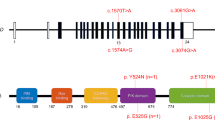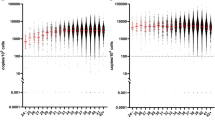Abstract
Fanconi anemia (FA), a rare genetic disease in which patients' life is compromised mainly by hematological abnormalities and cancer prone, seems to be affected by subtle immune cell irregularities. Knowing that FA presents developmental abnormalities and, based on recent reports, suggesting that natural killer (NK) CD56dim and NK CD56bright correspond to sequential differentiation pathways, we investigated if there were changes on the total number of NK cells and subsets as well as on T CD4 and T CD8 lymphocytes and their ratio. A large sample of FA patients (n = 42) was used in this work, and the results were correlated to clinical hematological status of these patients. Among FA patients, a decreased proportion of T CD8+ and NK CD56dimCD16+ cells were observed when compared to healthy controls as well as an imbalance of the subsets NK lymphocytes. Data suggest that FA patients might have a defective cytotoxic response due to the lower number of cytotoxic cells as well as impairment in the differentiation process of the NK cells subsets which may be directly related to impairment of the immune surveillance observed in these patients.




Similar content being viewed by others
References
Joenje H, Patel KJ (2001) The emerging genetic and molecular basis of Fanconi anaemia. Nat Rev Genet 2:446–457
Bagby JRGC (2003) Genetic basis of Fanconi anemia. Curr Opin Hematol 10:68–76
D'Andrea AD, Grompe M (2003) The Fanconi anaemia/BRCA pathway. Nat Rev Cancer 3:23–34
Kennedy RD, D'Andrea AD (2005) The Fanconi anemia/BRCA pathway: new faces in the crowd. Genes Dev 19:2925–2940
Li X, Yang Y, Yuan J, Hong P, Freie B, Orazi A, Haneline LS, Clapp DW (2004) Continuous in vivo infusion of interferon-gamma (IFN-γ) preferentially reduces myeloid progenitor numbers and enhances engraftment of syngeneic wild-type cells in Fancc−/− mice. Blood 104(4):1204–1209
Freie B, Li X, Ciccone SLM, Nawa K, Cooper S, Vogelweid C, Schantz L, Haneline LS, Orazi A, Broxmeyer HE, Lee S, Clapp DW (2003) Fanconi anemia type C and p53 cooperate in apoptosis and tumorigenesis. Blood 102(12):4146–4152
Hucl T, Gallmeier E (2011) DNA repair: exploiting the Fanconi anemia pathway as a potential therapeutic target. Physiol Res 60:453–465
Sejas DP, Rani R, Qiu Y, Zhang X, Fagerlie SR, Nakano H, Williams DA, Pang Q (2007) Inflammatory reactive oxygen species-mediated hemopoietic suppression in Fancc-deficient mice. J Immunol 178:5277–5287
Ibáñez A, Río P, Casado JA, Bueren JA, Fernández-Luna JL, Pipaón C (2009) Elevated levels of IL-1β in Fanconi anaemia group A patients due to a constitutively active phosphoinositide 3-kinase-Akt pathway are capable of promoting tumour cell proliferation. Biochem J 422:161–170
Hersey P, Edwards A, Lewis R, Kemp A, Mcinnes J (1982) Deficient natural killer cell activity in a patient with Fanconi's anaemia and squamous cell carcinoma. Association with defect in interferon release. Clin Exp Immunol 48(1):205–212
Fagerlie SR, Bagby GC (2006) Immune defects in Fanconi anemia. Crit Rev Immunol 26(1):81–96
Zaizov R, Matoth Y, Mamon Z (1978) Long term observations in children with Fanconi's anemia. In: Hibino S et al (eds) Aplastic anemia. University Park Press, Baltimore, p 243
Pederson FK, Hertz H, Lundsteen C, Platz P, Thomsen M (1977) Indications of primary immune deficiency in Fanconi's anaemia. Acta Paediatr Scand 66:745
Myers KC, Bleesing JJ, Davies SM, Zhang X, Martin LJ, Mueller R, Harris RE, Filipovich AH, Kovacic MB, Wells SI, Parinda A, Mehta PA (2011) Impaired immune function in children with Fanconi anaemia. Br J Haematol 154:234–240
Korthof ET, Svahn J, Peffault de Latour R et al (2013) Immunological profile of Fanconi anemia: a multicentric retrospective analysis of 61 patients. Am J Hematol 88(6):472–476
Chávez-Galán L, Arenas-Del Angel MC, Zenteno E, Chávez R, Lascurain R (2009) Cell death mechanisms induced by cytotoxic lymphocytes. Cel Mol Immunol 6(1):15–25
Cooley S, Weisdorf DS (2010) Natural killer cells and tumor control. Cur Opin Hematol 17:514–521
Penack O, Gentilini C, Fischer L, Asemissen AM, Scheibenbogen C, Thiel E, Uharek L (2005) CD56dimCD16neg cells are responsible for natural cytotoxicity against tumor targets. Leukemia 19:835–840
Moretta A, Marcenaro E, Parolini S, Ferlazzo G, Moretta L (2008) NK cells at the interface between innate and adaptive immunity. Cell Death Diff 15:226–233 (review)
Orr MT, Lanier LL (2010) Natural killer cell education and tolerance. Cell 142:847–856
Tarazona R, Casado JG, Delarosa O et al (2002) Selective depletion of CD56(dim) NK cell subsets and maintenance of CD56(bright) NK cells in treatment-naive HIV-1-seropositive individuals. J Clin Immunol 22(3):176–183
Hong HS, Eberhard JM, Keudel P et al (2010) Phenotypically and functionally distinct subsets contribute to the expansion of CD56−/CD16+ natural killer cells in HIV infection. AIDS 24(12):1823–1834
Schepis D, Gunnarsson I, Eloranta ML et al (2009) Increased proportion of CD56bright natural killer cells in active and inactive systemic lupus erythematosus. Immunology 126(1):140–146
Saraste M, Irjala H, Airas L (2007) Expansion of CD56Bright natural killer cells in the peripheral blood of multiple sclerosis patients treated with interferon-beta. Neurol Sci 28(3):121–126
Lee S, Watson MW, Flexman JP, Cheng W, Hammond T, Price P (2010) Increased proportion of the CD56(bright) NK cell subset in patients chronically infected with hepatitis C virus (HCV) receiving interferon-alpha and ribavirin therapy. J Med Virol 82(4):568–574
Auerbach AD, Rogatko A, Schroeder-Kurth TM (1989) International Fanconi Anemia Registry: relation of clinical symptoms to diepoxybutane sensitivity. Blood 73:391–396
Cooper MA, Fehniger TA, Caligiuri MA (2001) The biology of human natural killer-cell subsets. Trends Immunol 22(11):633–640
Baruque GA, Bitencourt MA, Pasquini R, Castelo-Branco MTL, Llerena JRJC, Rumjanek VM (2005) Apoptosis and expression of anti- and pro-apoptotic proteins in peripheral blood mononuclear cells of Fanconi anaemia patients: a study of 73 cases. Eur J Haematol 75:384–390
Castello G, Gallo C, Napolitano M, Ascierto PA (1998) Immunological phenotype analysis of patients with Fanconi's anaemia and their family members. Acta Haematol 100(1):39–43
Zhang N, Bevan MJ (2011) CD8+ T cells: foot soldiers of the immune system. Immunity 35:161–168
Strioga M, Pasukoniene V, Characiejus D (2011) CD8+ CD28− and CD8+ CD57+ T cells and their role in health and disease. Immunology 134:17–32
Almeida-Oliveira A, Smith-Carvalho M, Porto LC, Cardoso-Oliveira J, Ribeiro AS, Falcão RR, Abdelhay E, Bouzas LF, Thuler LCS, Ornellas MH, Diamond HR (2011) Age-related changes in natural killer cell receptors from childhood through old age. H Immunol 72:319–329
Froom P, Aghai E, Dobinsky JB, Quitt M, Lahat N (1987) Reduced natural killer activity in patients with Fanconi's anemia and in family members. Leuk Res 11(2):197–199
Lebbé C, Pinquier L, Rybojad M, Chomienne C, Ochonisky S, Miclea JM, Gluckman E, Morel P (1993) Fanconi's anaemia associated with multicentric Bowen's disease and decreased NK cytotoxicity. Br J Dermatol 129(5):615–618
Moretta L (2010) Dissecting CD56dim human NK cells. Blood 116(19):3689–3691
Chan A, Hong DL, Atzberger A, Kollnberger S, Filer AD, Buckley CD, McMichael A, Enver T, Bowness P (2007) CD56bright human NK cells differentiate into CD56dim cells: role of contact with peripheral fibroblasts. J Immunol 179:89–94
Loza MJ, Perussia B (2004) The IL-12 signature: NK cell terminal CD56+high stage and effector functions. J Immunol 172:88–96
de Matos CT, Berg L, Michaëlsson J, Fellander-Tsai L, Kärre K, Söderström K (2007) Activating and inhibitory receptors on synovial fluid natural killer cells of arthritis patients: role of CD94/NKG2A in control of cytokine secretion. Immunology 122:291–301
Belisle JA, Gubbels JA, Raphael CA et al (2007) Peritoneal natural killer cells from epithelial ovarian cancer patients show an altered phenotype and bind to the tumour marker MUC16 (CA125). Immunology 122:418–429
Katchar K, Söderström K, Wahlstrom J, Eklund A, Grunewald J (2005) Characterisation of natural killer cells and CD56+ T-cells in sarcoidosis patients. Eur Respir J 26:77–85
Inngjerdingen M, Kveberg L, Naper C, Vaage JT (2011) Natural killer cell subsets in man and rodents. Tissue Antigens 78:81–88
Takahashi E, Kuranaga N, Satoh K, Habu Y, Shinomiya N, Asano T, Seki S, Hayakawa M (2007) Induction of CD16+CD56bright NK cells with antitumour cytotoxicity not only from CD16−CD56bright NK cells but also from CD16−CD56dim NK cells. Scand J Immunol 65:126–138
Rosselli F, Sanceau J, Gluckman E, Wietzerbin J, Moustacchi E (1994) Abnormal lymphokine production: a novel feature of the genetic disease Fanconi anemia: II. In vitro and in vivo spontaneous overproduction of tumor necrosis factor α. Blood 83:1216–1225
Rathbun RK, Faulkner GR, Ostroski MH, Christianson TA, Hughes G, Jones G, Cahn R, Maziarz R, Royle G, Keeble W, Heinrich MC, Grompe M, Tower PA, Bagby GC (1997) Inactivation of the Fanconi anemia group C gene augments interferon-γ-induced apoptotic response in hematopoietic cells. Blood 90:974–985
Pilonetto DV, Pereira NF, Bitencourt MA, Magdalena NIR, Vieira ER, Veiga LBA, Cavalli IJ, Ribeiro RC, Pasquini R (2009) FANCD2 Western blot as a diagnostic tool for Brazilian patients with Fanconi anemia. Br J Med Biol Res 42:237–243
Levitus M, Rooimans MA, Steltenpool J, Cool NF, Oostra AB, Mathew CG et al (2004) Heterogeneity in Fanconi anemia: evidence for 2 new genetic subtypes. Blood 103:2498–2503
Shimamura A (2006) Inherited bone marrow failure syndromes: molecular features. Hematology Am Soc Hematol Educ Program 63–71
Acknowledgments
This work was supported by the National Counsel of Technological and Scientific Development (CNPq) and the Rio de Janeiro State Foundation for the Support of Research (FAPERJ).
Conflict of interest
The authors declare that they have no conflict of interest.
Author information
Authors and Affiliations
Corresponding author
Rights and permissions
About this article
Cite this article
Justo, G.A., Bitencourt, M.A., Pasquini, R. et al. Immune status of Fanconi anemia patients: decrease in T CD8 and CD56dim CD16+ NK lymphocytes. Ann Hematol 93, 761–767 (2014). https://doi.org/10.1007/s00277-013-1953-4
Received:
Accepted:
Published:
Issue Date:
DOI: https://doi.org/10.1007/s00277-013-1953-4




